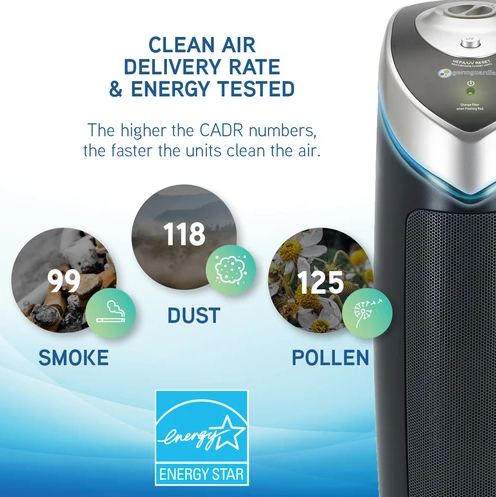CADR stands for Clean Air Delivery Rate and it is a measure of how fast an air purifier can clean air within a given room size. CADR rating is given in three categories that are dust, smoke, and pollen, and the rating is taken in cubic feet per minute (CFM).
The numerical value shows you how much dust, pollen, and smoke particles can be removed from the air in a minute, respectively. The three particles are used to determine the CADR rating because they are the most common air pollutants and they represent small, medium, and large particles in the air.
Smoke size ranges 0.1 to 0.3 microns representing small air particles, dust size ranges 0.5 to 3 microns representing medium-sized particles, and pollen measures 5 to 11 microns representing large particles.
The higher an air purifier scores in each category, the faster it can remove the specific particle from the air. The highest recorded ratings are 450 for smoke and pollen and 400 for dust.
It is also important to understand that when looking at the CADR of a certain air purifier; you must consider the maximum room size the purifier was built for. For example, an air purifier with a CADR of 400 CFM will be more effective in a 400 sq. ft. room compared to one with a CADR of 300 CFM.
So, it is safe to say that the higher the CADR the more powerful the air purifier. However, CADR does not measure the efficiency of an air purifier. Cleaning capability is only determined by the filtration type and technology used.
Who calculates CADR?
CADR ratings were invented and are calculated by the Association of Home Appliance Manufacturers (AHAM). CADR from AHAM is currently the most accurate because they use the same test for all air purifiers. Also, different brands present their air purifiers voluntarily for testing.

How is CADR measured?
CADR ratings are strictly measured through a test called the ANSI/AHAM AC-1 standard. The process is simple yet accurate as explained below:
- An air purifier is tested in a 1008 cu. ft. room
- The number of contaminants in the room are determined before the testing starts
- The air purifier is run on the highest fan speed for 20 minutes with a new and clean filter
- After 20 minutes the air purifier is stopped and the contaminants in the air measured again
- The difference in contaminants is taken and the CADR determined
Pros of CADR
- Allows buyers to objectively compare air purifiers before purchase
- Enables customers to buy an air purifier that best suits their needs. For example, if your main aim is to eliminate dust, you will choose an air purifier with the highest dust CFM.
- Since the test is conducted by a neutral third party, so the CADR results are unbiased.
Cons of CADR
- The test does not include gases, odors, microscopic air particles, and VOCs.
- The rating is tested when the air purifier is in the highest setting. The assumption that the CADR will be effective in a low-speed setting is not right.
- The 20-minute test puts a limit to the test because you cannot tell how it will perform after a month.
Conclusion
Looking at the CADR is a good starting point when buying an air purifier and comparing performance. Depending on your air purification needs, you will be able to understand the effectiveness of the device against the three common air pollutants – dust, pollen, and smoke.
However, note that the CADR test does not measure the effectiveness of the device on gases and very small air particles. Nonetheless, the best air purifiers Canada have a high CADR.
Therefore, if you want to invest in an air purifier because you suffer from asthma or allergic reactions, a higher CADR does not mean effectiveness. Check on other factors like the filtration type and technology of the air purifier.
